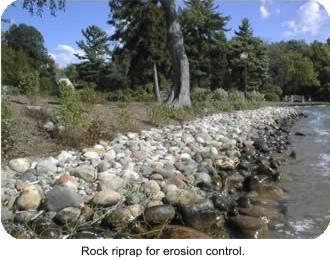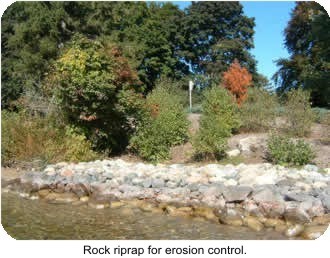Landscape Professionals
Many lakefront property owners will look to their landscape professionals for advice on shoreline restoration. Although every property is different and every client’s tastes are different, there are a few principles that guide lake-friendly shoreline restoration. Within these principles are varying degrees of “naturalization.” Through close communication and planning, the landscape professional will be able to assist his/her client in determining what works for the family, the property and the lake. Remember to review permit requirements before starting any shoreline project.
Stormwater Retention
Trapping and infiltrating stormwater has become a key component in protecting and improving lake water quality. Rainwater collecting on rooftops, walkways and parking lots tends to move over land to the lake, taking with it soil particles, lawn fertilizers and vehicle fluids. Development around lakes many times creates “pinch points” that collect and funnel stormwater into and through a property, causing soil erosion and washouts. Understanding vegetated solutions to a range of stormwater problems around lakes can equip landscape professionals to address these problems within the context of a lakescaping plan. KBS Landscape One demonstrates a simple solution to overland flow of stormwater. However, more technical solutions may be called for depending on the surface upon which stormwater is collected and the potential for pollutants.
Habitat Enhancement
Wildlife viewing is one reason people enjoy living on lakes. Through publications like “Lakescaping for Wildlife and Water Quality” lakefront property owners are realizing that restoring native shoreline vegetation can enhance that experience. The Michigan Native Plant Producers Association and the Wildflower Association of Michigan are resources for native plants and seed, education and for suppliers.
Shoreline Erosion Control
The proliferation of vertical sea walls around inland lakes is causing problems for lake ecosystems. They create an abrupt interruption of a natural transition from land to water. Wave energy is no longer absorbed by natural shoreline slope and vegetation, but is diverted downward and to neighboring properties. Many times shoreline erosion is made worse by a level control structure that places the lake surface at an unnaturally high level and in contact with soils less able to withstand the erosive forces of waves and ice. Many shoreline property owners are looking for erosion control alternatives to vertical seawall.
Rock riprap that slopes into the lake provides hard-armor but also allows for movement of reptiles and amphibians from water to land. Spaces between the rocks also provides cover for fish and crustaceans. It is necessary to line rip-rap with geotextile fabric to prevent soil particles from being dislodged by wave energy. Interplanting, or joint planting, with woody shrubs can create a softer look, disperse wave energy and create more wildlife habitat at the water’s edge.
Soft-armored, vegetative solutions to control shoreline erosion can vary from a simple buffer strip of long-rooted native plants and shrubs to soil bioengineered structures similar to those used in the KBS Shoreline Management Demonstration Area. To meet customer demands for more natural solutions, new products and techniques are continually being developed to vegetatively control shoreline erosion.
Please check back for more information.

